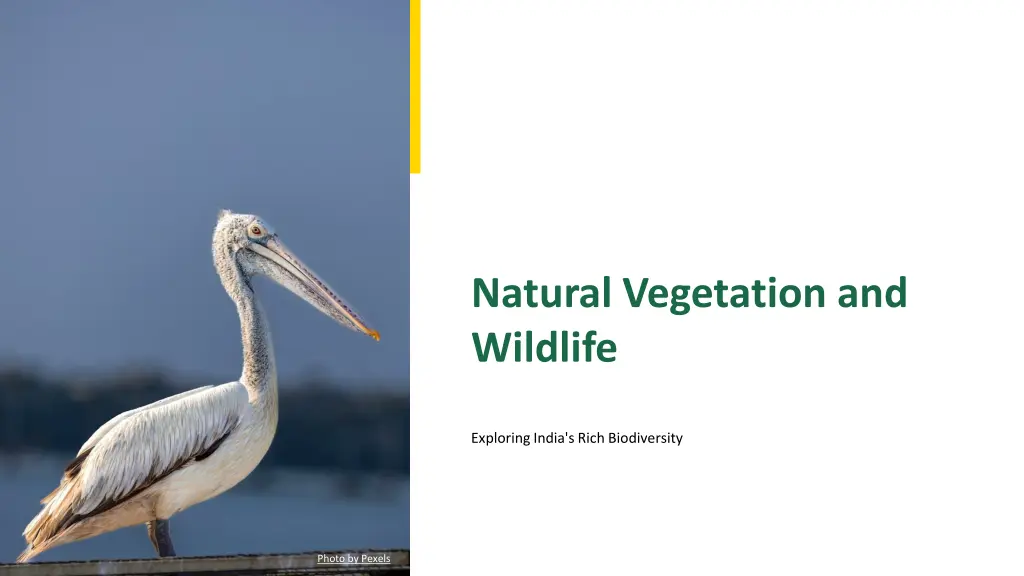
Exploring India's Diverse Natural Vegetation and Wildlife
Discover India's rich biodiversity through its natural vegetation and wildlife. From tropical evergreen forests to mangrove ecosystems, delve into the various types of vegetation found in different regions of India. Learn about the endemic and exotic species that call this diverse landscape home.
Uploaded on | 0 Views
Download Presentation

Please find below an Image/Link to download the presentation.
The content on the website is provided AS IS for your information and personal use only. It may not be sold, licensed, or shared on other websites without obtaining consent from the author. If you encounter any issues during the download, it is possible that the publisher has removed the file from their server.
You are allowed to download the files provided on this website for personal or commercial use, subject to the condition that they are used lawfully. All files are the property of their respective owners.
The content on the website is provided AS IS for your information and personal use only. It may not be sold, licensed, or shared on other websites without obtaining consent from the author.
E N D
Presentation Transcript
Natural Vegetation and Wildlife Exploring India's Rich Biodiversity Photo by Pexels
01 Introduction to India's Biodiversity Table of Contents 02 Understanding Natural Vegetation 03 Types of Vegetation in India 04 Tropical Evergreen Forests 05 Tropical Deciduous Forests 06 Tropical Thorn Forests and Scrubs 07 Montane Forests 08 Mangrove Forests 09 Endemic and Exotic Species 10 Flora and Fauna of India 11 Conclusion
1 Introduction to India's Biodiversity A Glimpse into Nature's Bounty India, a vast country, boasts a variety of bio-forms across its regions. India is one of the 12 mega biodiversity countries globally, with rich flora and fauna. With about 47,000 plant species, India ranks tenth in the world for plant diversity. India is home to approximately 90,000 animal species, including a rich variety of fish. Photo by Pexels
2 Understanding Natural Vegetation The Essence of Virgin Vegetation Natural vegetation refers to plant communities grown naturallywithout human aid. Plants undisturbed by humans for a long time are termed as virgin vegetation. Cultivated crops and fruits are part of vegetation but not natural vegetation. Purely Indian vegetation is known as endemic or indigenous species. Photo by Pexels
3 Types of Vegetation in India Exploring the Major Types Found in heavy rainfall areas like Western Ghats, these forests are lush and diverse. These forests shed their leaves in dry seasons and are widespread in India. Located in arid regions, these forests have thorny trees and bushes. Montane forests are in hilly areas, while mangroves are found in coastal regions. Photo by Pexels
4 Tropical Evergreen Forests Lush Greenery in Rainfall Areas Restricted to heavy rainfall areas like Western Ghats and Andaman Islands. Thrives in areas with over 200 cm of rainfall and a short dry season. Features a luxuriant growth of trees, shrubs, and creepers. Trees can reach heights of up to 60 meters or more. Photo by Pexels
5 Tropical Deciduous Forests The Shedding Forests These forests shed leaves in dry seasons to conserve water. Found across various regions in India, adapting to seasonal changes. Home to a variety of trees that adapt to changing seasons. Provides valuable timber and other forest products. Photo by Pexels
6 Tropical Thorn Forests and Scrubs Survival in Arid Regions These forests are adapted to survive in arid and semi-arid regions. Characterized by thorny trees and bushes to conserve water. Survive in areas with minimal rainfall and harsh conditions. Home to uniqueplant species adaptedto dry climates. Photo by Pexels
7 Montane Forests Forests in the Hills Found in hilly and mountainous regions of India. Plants adapted to varying altitudes and cooler climates. Rich in diverse plant species, including conifers and broadleaf trees. Crucial for maintaining ecological balance in hilly areas. Photo by Pexels
8 Mangrove Forests Coastal Guardians Found in coastal regions, especially in deltas and estuaries. Adapted to survive in saline and brackish water conditions. Home to diverse species of plants and animals. Protects coastlines from erosion and supports marine life. Photo by Pexels
9 Endemic and Exotic Species Understanding Flora and Fauna Species native to India, known as endemic or indigenous. Species introduced from outside India, termed as exotic. Flora refers to plants, while fauna refers to animal species. Both endemic and exotic species contribute to biodiversity. Photo by Pexels
10 Flora and Fauna of India A Rich Tapestry of Life India hosts a wide variety of flowering and non-flowering plants. Rich in animal species, including mammals, birds, and reptiles. Diverse fish species thrive in India's fresh and marine waters. Ongoing efforts to preserve India's rich biodiversity. Photo by Pexels
11 Conclusion Celebrating India's Natural Heritage India's biodiversity is a source of pride and inspiration. Preserving natural vegetation and wildlife is crucial for future generations. Understanding biodiversity enriches our knowledge and appreciation of nature. Encourage efforts to protect and conserve India's natural heritage. Photo by Pexels
